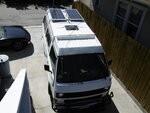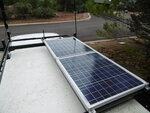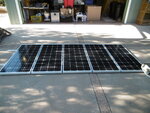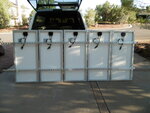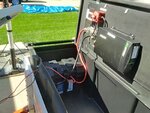I'm writing this for the random stranger who had a great idea, Googled "solar charge ebike battery", clicked on the first link and then read all the way to the bottom of page 2 of this thread. Congratulations fellow internet researcher. You have demonstrated perseverance and tenacity, both of which will serve you well on your quest!
About me: I have logged 50,000 miles (80,000 km) on ebikes over the past 13 years. Most of those were commuting miles without solar panels but several thousand were touring miles with solar panels for charging the bike. I have built several solar ebikes over the years and I'm pleased to report that it is indeed possible to combine these technologies. Whether or not it makes sense to do so will depend on your goals. More on that later.
To answer the OP's question, if you're only doing a couple of weekend ebike trips each year my advice would be to skip the solar panels, borrow a friend’s battery and charger in addition to your own and find electrical outlets en route. In fact, anyone who has reliable access to electrical outlets at the end of each day will find solar ebikes less convenient and more expensive. Assuming you can travel to your fishing destination on one battery charge from home and there are no outlets at your destination but you're going to spend a couple of days in the same place and you only need to top off your battery for the return trip home then you could get a
50 watt panel and be good to go but this is a very narrow use case.
However, if we're talking about serious long-distance touring in the range of hundreds or thousands of miles then
solar can be both feasible and economical, especially if your route takes you away from electrical outlets.
You can use any solar panel you want but "semi flexible" panels made with Sunpower cells for boats and RVs are your best choice in terms of power per unit weight and ability to withstand rough treatment on a bike. You can find them in all kinds of sizes on your favorite shopping site for around US$2 per watt and up. Traditional glass/aluminum frame rooftop panels are too heavy and should be avoided. "Folding" panels of the "solar blanket" variety are overpriced and impractical unless your idea of touring involves only 1-2 hours of riding per day and you absolutely, positively must stow your panels while riding because you're touring Ethiopia and the local children are throwing rocks at you.
Everyone else, please stop asking "how long will it take to charge my battery?" That's your grid-based ride-charge-ride habit talking. Solar ebikes are different. On a properly configured solar ebike, most of the solar energy is used directly by the motor controller while riding without a wasteful round trip through the battery. You still need a battery to collect solar energy when you stop, for extra help up hills, when it's cloudy, for regenerative braking, etc. Ignore the YouTube videos demonstrating "no battery" solar conversions unless your intent is to ride to the end of your street and back and then brag about it on InstaGram.
The question you should be asking is "how many miles per day can I get with a 100 watt solar panel? 200 watt? 400 watt?" The answer is about 3.5 to 4 watt-hours per watt in the summer. Assuming you can manage to pack light and always pedal at a moderate effort then you can expect to consume about 15 watt-hours per mile (9 Wh/km) while averaging 14 mph (23 kph). That means the 100 watt panel will get you 23 miles per day (100*3.5/15), the 200 watt panel 46 miles per day and the 400 watt panel 93 miles per day or 37 km, 74 km and 150 km respectively. Obviously, if you're riding uphill into a headwind in the rain without pedaling then your mileage will vary. These are long-term average values. You’ll get more on a sunny day, less on a cloudy day. If you're physically unable to pedal, cut these range values in half.
- 100 watts: you're either riding a very short distance each day or you're riding from electrical outlet to outlet, supplementing a bit with solar or maybe you just like the attention you get from having a solar panel on your bike (there's an accompanying paparazzi effect)
- 200 watts: bare minimum for off-grid ebike touring, anything less than this and you could travel further each day by ditching the solar panel, motor and battery weight (assuming you're physically fit)
- 400 watts: starting to get seriously heavy and unwieldy, borderline unrideable if electrical assist fails
The catch is that you must mount your solar panel so that it collects energy all day whether you are riding or not. If you cannot accept this then solar ebikes are not for you. This is the only way the weight/energy ratio makes sense. The simplest option is a bike trailer. Most trailers will fit a 100-150 watt panel easily. Beyond that, you will need to get creative. Recumbents and cargo bikes are popular in the 200-400 watt category but I've seen some awkward attempts to attach this much to a conventional upright bike.
The size of your battery has some bearing on the efficiency of your system but does not determine your range in an off-grid situation. Assuming you're trying to maximize distance traveled in a day, a bigger battery means you can take longer breaks before you battery hits 4.2V/cell at which point you have to choose between getting back on the road or wasting potential solar energy because it has nowhere to go. That's right, longer charge times are actually a feature. Conversely, an undersized battery (300-400 Wh) coupled with a large solar panel may run into problems with too much charging current for the battery cells or the BMS to handle. In that case, you’ll need to explore getting a bigger battery or using multiple batteries with multiple charge controllers.
Speaking of which, how do you connect your solar panels to your battery? You’ll need a "
boost solar charge controller." Just copy and paste those words into your favorite shopping site. You should find a couple of inexpensive Chinese models with MPPT for around US$30-45. The output can be programmed for 36V, 48V or 52V lithium packs. If you have the budget, you should get a
Genasun boost controller for US$205. These are not programmable but are available in fixed output voltages and are fully potted and waterproof instead of having loud cooling fans which suck in dust and moisture like some of the cheaper models.
These controllers have PV input ranges which will work with most solar panels -- just make sure that the open circuit voltage of your panel ("Voc") is less than your battery voltage when empty (around 3.3V per cell) or you may find that you are not able to charge when the input voltage is higher than the output voltage under some conditions (low battery on a cold day). You may be able to connect two small panels in parallel but with larger panels that will likely exceed the maximum input current so you may need multiple charge controllers. A higher input voltage will result in better controller efficiency than a lower input voltage but connecting panels in parallel gives you better partial shading mitigation so there are trade-offs to be made. Read the specifications. I mean it.
If you have a Bosch, Yamaha or Shimano battery... I offer you my condolences. These closed, proprietary systems make it much more difficult to modify and enjoy your bike as you see fit. They’re well-engineered systems designed to maximize corporate shareholder value and minimize liability and warranty claims. They have no interest in helping you with your wacky solar modification project or supporting inter-operability with equipment from other vendors. If you're doing pre-purchase research and solar charging is important to you then brands which reject open standards do not belong on your short list.
I’ve read that you can trick the Bosch batteries into accepting a charge from a non-Bosch source by applying +5V to the signal pin and keeping charge current at 4A or less. If anyone knows a similar trick that will work with Yamaha or Shimano, please share with the rest of us? I know several solar ebike enthusiasts who charge using AC inverters on the bike but these workarounds are heavy and inefficient. They should only be considered as an option of last resort.
I have written extensively about my solar conversions. I mention this as proof of real world experience in this subject matter and not as an example of a low cost beginner project. Hopefully, my build will provide some inspiration for those of you who managed to read past the negative "it can't be done" posts above. You can do it. Start small and keep it simple. Add more later after you've had your first success. It’s not rocket science. If budget is an issue, you may find used solar panels on eBay, craigslist or your local equivalent. Or reach out to local solar installers or RV/boat supply shops and ask if they have any returned, blemished or damaged panels they're willing to donate to you. Most of all, stop "thinking about it" and get out there and start doing something about it.
My current build has a 315 watt solar array good for around 80 miles (130km) per day. Just for fun, I recently did a 207 mile (333km) single-day ride using 784 Wh from grid-charged batteries and generating 2266 solar Wh. Here's some video.
If you want to learn more, I recommend watching the following presentation from someone who is far more knowledgeable than I.
Happy solar biking.
